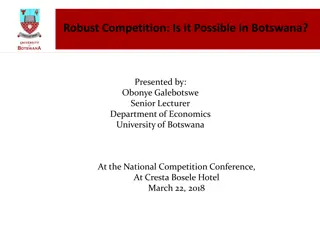Competition Policy and Economic Growth in Latin America
This study explores the relationship between competition policy and economic growth in Latin America, comparing indicators such as local competition intensity and effectiveness of antimonopoly policy across various countries. The findings suggest that Latin American countries lag behind developed nations in competition levels, impacting their economic structures and growth potential.
Download Presentation

Please find below an Image/Link to download the presentation.
The content on the website is provided AS IS for your information and personal use only. It may not be sold, licensed, or shared on other websites without obtaining consent from the author. Download presentation by click this link. If you encounter any issues during the download, it is possible that the publisher has removed the file from their server.
E N D
Presentation Transcript
Competition Policy and Economic Growth: Evidence from Latin America Esteban Greco Diego Petrecolla Carlos A. Romero
Economic structure and competition policy indicators Considering 148 countries covered by the World Competitiveness Report, => LACs fall below the competition levels of developed countries measured by the most comprehensive indicators, such as: intensity of local competition effectiveness of the antimonopoly policy. => LACs also fall below the worldwide average in these variables.
Economic structure and competition policy indicators III Table 1: Measures of competition extent, worldwide comparison Economic Structure Competition Intens. of local competition, 1-7 (best) Eff. of anti- monopoly policy, 1-7 (best) GDP per capita (PPP) Share on World GDP Public institutions, 1-7 (best) Trade tariffs, % duty No. days to start a business Subsidies, 0 (best) - 10 Region TFP growth Openess (X+M/GDP) Govbudg / GDP Life Human development Infrastructure expectancy Latam Euro Zone Nafta Oceania World 12698 31837 49622 41256 12445 8.5% 19.6% 20.9% 1.3% 100.0% -0.62 -0.59 0.01 -0.93 0.39 47.1% 91.2% 33.8% 43.1% 64.7% 3.26 5.00 4.91 5.59 3.94 -2.78 -2.90 -5.86 -2.80 -1.66 3.66 5.58 5.79 5.41 3.95 74.34 80.98 79.79 81.38 70.63 0.741 0.881 0.935 0.857 0.694 4.58 5.48 5.72 5.54 4.80 3.60 5.06 5.22 5.45 4.00 6.69 1.17 1.95 3.03 6.86 39.41 13.15 5.50 1.50 28.57 8.12 4.82 6.75 7.10 6.47 Source: The authors own elaboration based on the Conference Board, World Economic Forum, and United Nations data.
Economic structure and competition policy indicators V Table 2: Measures of competition extent, Latin American countries Economic Structure Competition Public institutions, 1-7 (best) Intens. of local competition, 1-7 (best) Eff. of anti- monopoly policy, 1-7 (best) Trade tariffs, % duty No. days to start a business Region GDP per capita (PPP) Share on LACs GDP Openess (X+M/GDP) Govbudg / GDP Life Human development Subsidies, 0 (best) - 10 TFP growth Infrastructure Expectancy Chile 18561 4.57% -0.82 68.73% 4.75 0.61 4.54 79.02 0.819 5.54 4.92 4.67 8.00 7.30 Brazil 11978 33.56% -0.37 24.70% 3.35 -2.76 4.02 73.44 0.73 5.14 4.48 11.27 119.00 6.60 El Salvador 7439 0.66% - 75.25% 3.17 -3.84 4.01 71.95 0.68 5.06 3.64 4.39 17.00 9.10 Costa Rica 12445 0.84% -2.09 80.65% 4.09 -4.62 3.92 79.32 0.773 5.06 4.11 3.62 60.00 9.30 Peru 11111 4.65% 1.63 50.43% 3.14 2.02 3.50 73.98 0.741 5.03 3.98 1.91 26.00 9.50 Guatemala 5332 1.12% 0.11 63.80% 3.00 -2.44 3.83 71.07 0.581 5.03 3.38 4.84 40.00 9.00 Panama 15983 0.81% - 143.83% 3.66 -2.14 4.89 76.15 0.78 4.89 4.35 5.97 7.00 8.60 Colombia 10716 7.17% -1.63 37.01% 3.23 0.18 3.50 73.64 0.719 4.83 3.94 6.60 13.00 7.50 Mexico 15322 25.06% -1.43 67.33% 3.28 -3.71 4.14 76.89 0.775 4.76 3.49 8.30 9.00 7.90 Honduras 4875 0.54% - 118.48% 3.15 -4.33 2.81 73.11 0.632 4.37 3.41 4.45 14.00 - Paraguay 6223 0.58% - 94.30% 2.57 -1.01 2.66 72.48 0.669 4.33 2.93 6.77 35.00 - Uruguay 15967 0.77% 1.00 52.46% 4.55 -2.62 4.31 76.41 0.792 4.26 3.38 7.88 7.00 - Argentina 18230 10.59% 0.75 38.26% 2.72 -4.31 3.52 75.80 0.811 4.20 3.19 10.57 26.00 8.30 Ecuador 10449 2.18% -0.15 66.85% 2.88 -0.52 3.81 75.63 0.724 4.15 3.00 7.46 56.00 - Nicaragua 4543 0.38% - 95.55% 3.04 -0.52 3.14 74.00 0.599 3.92 3.13 3.99 39.00 7.80 Bolivia 5475 0.79% 1.40 78.40% 2.82 1.76 2.98 66.58 0.675 3.89 3.02 8.52 50.00 8.80 Venezuela 13727 5.73% -2.08 46.11% 2.06 -18.94 2.61 74.31 0.748 3.39 2.91 12.59 144.00 5.80 Source: Authors own elaboration based on the Conference Board, World Economic Forum, and United Nations data.
Competition policy and growth in LACs I We estimated the relation between competition and GDP per capita (GDPC) for a sample of 148 countries worldwide and for LACs. We assume that the intensity of local competition (ILC) is a driver for the GDPC. Three sources for economic development: investment, increased trade and other economic policies, such as human capital accumulation and institutional reform. We estimate a fixed-effect panel data regression model. The estimation sample of this paper consists of 148 countries for the years from 2006-07 to 2013-14, a total of eight years. Data is from the World Economic Forum. Pub_inst, Infrastr and ILC are perception indexes, Public institutions , Infrastructure and Intensity of local competition , respectively. These measures are collected from opinion surveys and are scaled from 1 to 7 with higher values representing stronger agreement with the statements. The rest are objective variables.
Competition policy and growth in LACs II Table 3: Estimation results under fixed effects Note: *** p<0.01, ** p<0.05, * p<0.1 Source: Authors own estimations.
Competition policy and growth in LACs IV The 3SLS Model by Bolaky (2013) and Krakowski (2005) controls for the endogeneity of competition on GDP. It is a more comprehensive approach were it is posited that the effectiveness of competition policy in promoting competition depends not only on whether a competition law exists but also on how effectively the competition legislation is applied. An equation of the effectiveness of the application of competition legislation (Eff_antim_pol) is estimated first. Second, an equation of the intensity of local competition is estimated with the effectiveness of the application of competition legislation as an explanatory variable. Finally, the third equation corresponds to the GDPC explained by the intensity of local competition among others. Year Dummy variables are also included in the model.
Competition policy and growth in LACs V Table 4: Estimation results under 3SLS Note: *** p<0.01, ** p<0.05, * p<0.1 Source: Authors own estimations.
Conclusions I Quantitative analysis enables us to examine the relationship between competition policies and GDP per capita more deeply. Remarkably, while there is a significant and positive correlation between the two worldwide, this is not the case in LACs. To explain this finding, leaving aside the accurateness of the indicators, GDP volatility, crisis and after- crisis growth could be important factors that operate in two ways: First, they increase the relevance of macroeconomic factors, and consequently reduce the relevance of competition policy as explanatory variables for GDP variations. Second, they downgrade competition policy in public policy priorities, as short-term macroeconomic factors dominate the agenda. In some countries, such as Argentina and Venezuela, high inflation could be a factor distorting competition, complicating price comparisons and generating policy reactions with regulations and government agreements that relegate competition policy to a lower level of significance.
Conclusions III LACs lack a history of consumer protection policies and competition culture development, but they show precedents of strong industrial policies and the protection of national champions, along with a weak performance of public institutions. In that context, short-term rent-seeking behavior has been fostered, given that competitive advantages and economic rents could be acquired from relatively discretional decisions, while fair competition is not always a predictable outcome. This kind of behavior could have led to growth strategies with less care for competition policy goals, but with an outcome of low productivity (TFP) relative to the rest of the world. A related conclusion is that competition policy alone is not enough to generate sustainable growth. Institutional arrangements need to be strong and credible to enforce competition law so that economic agents can see competition as a viable way to allocate resources.

 undefined
undefined














































